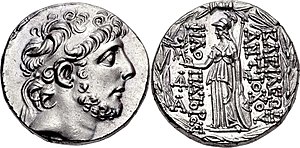| This article includes a list of general references, but it lacks sufficient corresponding inline citations. Please help to improve this article by introducing more precise citations. (January 2013) (Learn how and when to remove this message) |
| Antiochus IX Cyzicenus | |
|---|---|
| Antiochus IX Eusebes Cyzicenus | |
 Tetradrachm of Antiochos IX, with Athena Nike on the reverse, minted at Antioch circa 110-109 BC. Tetradrachm of Antiochos IX, with Athena Nike on the reverse, minted at Antioch circa 110-109 BC. | |
| King of Syria (Seleucid Empire) | |
| Reign | 116–95 BC |
| Predecessor | Antiochus VIII |
| Successors | Seleucus VI, Demetrius III |
| Contenders |
|
| Born | Unknown |
| Died | 96 BC |
| Spouse |
|
| Issue | Antiochus X Eusebes |
| Dynasty | Seleucid |
| Father | Antiochus VII Sidetes |
| Mother | Cleopatra Thea |
Antiochus IX Eusebes Cyzicenus (Greek: Ἀντίοχος Εὐσεβής Κυζικηνός, "Antiochus the Pious, the Cyzicene") was a ruler of the Hellenistic Seleucid kingdom. He was the son of Antiochus VII and Cleopatra Thea. He left the kingdom in 129 BC and went to the city of Cyzicus, but he returned in 116 BC to challenge his half-brother Antiochus VIII for power.
The siblings fought a twenty-year civil war. In 112 BC, Antiochus IX's wife, Cleopatra IV, was killed by her sister Tryphaena, the wife of Antiochus VIII. Tryphaena herself died shortly afterwards. Antiochus VIII was assassinated in 96 BC; he was succeeded by his sons Seleucus VI and Demetrius III. Antiochus IX then took the capital Antioch and married his deceased wife's sister Cleopatra Selene, who was herself the widow of Antiochus VIII. Seleucus VI continued the war against his uncle. Antiochus IX Eusebes Cyzicenus was killed in battle in 96 B.C.
Biography

The son of Antiochus VII and Cleopatra Thea, upon the death of his father in Parthia and his uncle Demetrius II's return to power (129 BC), his mother sent him to Cyzicus on the Bosporus, thus giving him his nickname.
Following the death of his mother c. 121 BC, Antiochus IX Cyzicenus challenged his half-brother, Antiochus VIII, for power over Syria.
He returned to Syria in 116 BC to claim the Seleucid throne from Antiochus VIII, with whom he eventually divided Syria, that same year.
Antiochus IX was first married to Cleopatra IV, who was said to have been killed in 112 BC by her sister and rival Tryphaena, wife of Antiochus VIII. Antiochus VIII was assassinated in 96 BC. Antiochus IX then captured Antioch and married his brother's widow, Cleopatra Selene, who was the sister of Cleopatra IV.
Antiochus IX was subsequently killed in battle against Antiochus VIII's son Seleucus VI later in 96 BC.
Legacy
Antiochus IX probably created the Iturean tetrarchy as an ally against Antiochus VIII.
See also
References
- Oliver D. Hoover, Handbook of Syrian Coins: Royal and Civic Issues, Fourth to First Centuries BC , Lancaster/London, Classical Numismatic Group, 2009, pp. 250-251.
- ^ Antiochus IX Cyzicenus entry in historical sourcebook by Mahlon H. Smith
- ARTHUR HOUGHTON, THE PORTRAIT OF ANTIOCHUS IX , Vereinigung der Freunde Antiker Kunst, 1984, pp. 123-128.
- ^ "E. R. Bevan: The House of Ptolemy • Chap. XI".
- Aidan Dodson, Dyan Hilton, The Complete Royal Families of Ancient Egypt, 2004
- Cleopatra Thea by Chris Bennett
- Justin 39, 3, 3-11.
- Wright 2005, p. 80.
Sources
- Wright, Nicholas L. (2005). "Seleucid Royal Cult, Indigenous Religious Traditions and Radiate Crowns: The Numismatic Evidence". Mediterranean Archaeology. 18. Sydney University Press: 81. ISSN 1030-8482.
- Vermeule, Cornelius (1970). "Near Eastern, Greek, and Roman Gems: A Recent Gift to the Collections". Boston Museum Bulletin. 68 (353). Museum of Fine Arts, Boston: 197–214. JSTOR 4171534. OCLC 866801443.
External links
- An engraved gem. Property of The Museum of Fine Arts, Boston. It probably depicts Antiochus IX.
| Antiochus IX Cyzicenus Seleucid dynastyBorn: Unknown Died: 96 BC | ||
| Preceded byAntiochus VIII | Seleucid King (King of Syria) 114–95 BC with Antiochus VIII (116–95 BC) |
Succeeded bySeleucus VI and Demetrius III |
- Vermeule 1970, p. 205.